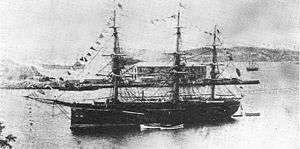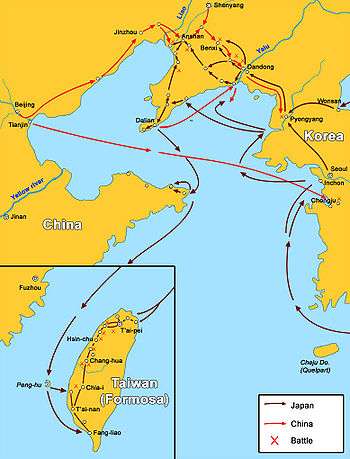Japanese invasion of Taiwan (1874)
| Taiwan Expedition of 1874 | |||||||||
|---|---|---|---|---|---|---|---|---|---|
| Part of the Formosa Conflict | |||||||||
 Commander-in-chief Saigo and his staff.  The Battle of Stonegate (石門進撃), May 22, 1874. | |||||||||
| |||||||||
| Belligerents | |||||||||
|
|
Paiwan | ||||||||
| Commanders and leaders | |||||||||
|
| Tauketok † | ||||||||
| Strength | |||||||||
|
Land: 3,600 Sea: unknown | unknown | ||||||||
| Casualties and losses | |||||||||
|
6 killed ~30 wounded | ~30 killed | ||||||||
| |||||||||
The Japanese punitive expedition to Taiwan in 1874, referred to in Japan as the Taiwan Expedition (Japanese: 台湾出兵 Hepburn: Taiwan Shuppei) and in Taiwan and mainland China as the Mudan incident (Chinese: 牡丹社事件), was a punitive expedition launched by the Japanese in retaliation for the murder of 54 Ryukyuan sailors by Paiwan aborigines near the southwestern tip of Taiwan in December 1871. The success of the expedition, which marked the first overseas deployment of the Imperial Japanese Army and Imperial Japanese Navy, revealed the fragility of the Qing dynasty's hold on Taiwan and encouraged further Japanese adventurism. Diplomatically, Japan's embroilment with China in 1874 was eventually resolved by a British arbitration under which Qing China agreed to compensate Japan for property damage. Some ambiguous wording in the agreed terms were later argued by Japan to be confirmation of Chinese renunciation of suzerainty over the Ryukyu Islands, paving the way for de facto Japanese incorporation of Ryukyu in 1879.
Background
In December 1871 a Ryukyuan vessel was shipwrecked near the southern tip of Taiwan. Fifty-four members of its crew of 66 were beheaded by the Paiwan aborigines. The remaining 12 crewmen were rescued by Han Chinese and were transferred to Tainan in southern Taiwan. The local Qing Chinese government officials transferred them to Fujian province in mainland China. From there, the Qing government arranged to send them back home.[2]
Diplomacy
When Japan sought compensation from Qing China, the court rejected the demand on the grounds that the "wild"/"unsubjugated" aboriginals (Chinese: 臺灣生番; pinyin: Táiwān shēngfān) were outside its jurisdiction. This open renunciation of sovereignty led to the Taiwan Expedition of 1874 by the Japanese.
The Meiji government of Japan demanded that the Qing government of China punish leaders of the Taiwanese aborigines responsible for the murders of the Ryukyuan crew. The Japanese foreign minister Soejima Taneomi went to Beijing, and was received in an audience by the Tongzhi Emperor (in itself a diplomatic triumph); however, his request for compensation was first rejected because China considered it an internal affair since Taiwan was part of Fujian Province of China and the Ryūkyū Kingdom had a tributary relationship with China. When Soejima Taneomi claimed four of the victims murdered were from Oda Prefecture, present-day Okayama Prefecture, Japan and asked for compensation again, Chinese officials refused him on the grounds that most of the Taiwanese aboriginals were outside effective Chinese control, and were thus sometimes exempt from judicial action. Charles Le Gendre, the French-born American military advisor to the Japanese government, as well as Gustave Emile Boissonade, legal advisor, urged that Japan take the matter into its own hands.
Expedition


The Japanese government agreed, and sent an expedition of 3,600 soldiers led by Saigō Tsugumichi in May 1874. The Japanese won a decisive victory at the Battle of Stone Gate on 22 May. Thirty Taiwan tribesmen were either killed or mortally wounded in the battle, and a considerably greater number wounded. Japanese casualties were 6 killed and 30 wounded.[4]
In November 1874 the Japanese forces withdrew from Taiwan after the Qing government agreed to an indemnity of 500,000 Kuping taels, or about 18.7 tonnes (600,000 ozt) silver. Sir Harry Parkes, the British minister to Japan, characterised this transaction as "China's willingness to pay to be invaded".
Aftermath
In 1875 the Qing authorities unsuccessfully attempted to bring the southeast coastal region of Taiwan under their control, despatching a column of 300 soldiers against the Paiwan. The Chinese troops were ambushed and routed by the Paiwan and their well-armed fighters. 250 Chinese soldiers were killed, and the 50 survivors retreated to Takow (Kaohsiung).[5]
Legacy
Although launched ostensibly to punish the local tribesmen for their murder of 54 Ryukyuan merchants, the 1874 punitive expedition to Taiwan served a number of purposes for Japan's new Meiji government. Japan had for some time begun claiming suzerainty, and later sovereignty, over the Ryūkyū Kingdom, whose traditional suzerain had been China. The expedition demonstrated that China was not in effective control of Taiwan, let alone the Ryukyu Islands. Japan was emboldened to more forcefully assert its claim to speak for the Ryukyuan islanders. The settlement in 1874, brokered by the British, included a reference to Chinese recognition that the Japanese expedition was "in protection of civilians", a reference that Japan later pointed towards as Chinese renunciation of its rights over Ryukyu. In 1879 Japan referred the dispute to British arbitration, and the British confirmed Japanese sovereignty over the Ryukyus, a result which was not recognised by China.[6] Nevertheless, Japan used this as the justification for taking de facto control over Ryukyu, moving the king of Ryukyu to Japan and incorporating Ryukyu as a prefecture of Japan. The ensuing Chinese protest led to the matter being submitted to US President Ulysses S. Grant as arbitrator, during which Japan offered to split Ryukyu between Japan and China. This was refused by China, but a weakened China was unable in practice to stop the Japanese annexation of the Ryukyus.
The surrendering aborigines were given Japanese flags to fly over their villages that they viewed as a symbol of peace with Japan and protection from rival tribes, however, the Japanese viewed them as a symbol of jurisdiction over the aborigines.[7] The expedition also served as a useful rehearsal for future Japanese imperial ambitions. Taiwan was already being viewed as a potential Japanese colony in some circles in Japan.[8]
Domestically, the action also mollified those within the Meiji government who were pushing for a more aggressive foreign policy, and who were enraged by the government's refusal in 1873 to attack Korea. It is significant that the expedition took place shortly after the Saga Rebellion, and was led by Saigō Jūdō (Saigō Takamori's younger brother) and consisted largely of former Satsuma and Saga samurai.
More generally, the Japanese incursion into Taiwan in 1874 and the feeble Chinese response was a blatant revelation of Chinese weakness and an invitation to further foreign encroachment in Taiwan. In particular, the success of the Japanese incursion was among the factors influencing the French decision to invade Taiwan in October 1884, during the Sino-French War. The Qing court belatedly attempted to strengthen its hold on Taiwan, and the Chinese imperial commissioner Shen Pao-chen made some improvements to the island's coastal defences during the second half of the 1870s. Further substantial improvements were made by the Chinese governor Liu Ming-ch'uan in the 1880s, in the wake of the French capture of Keelung during the Sino-French War. However, little was done to improve the poor quality of the Qing garrison of Taiwan, and both the French in 1884 and the Japanese in 1895 were able to land successfully in Taiwan.
See also
| Wikimedia Commons has media related to Japanese invasion of Taiwan (1874). |
Notes
- ↑ "WASHINGTON.; OFFICIAL DISPATCHES ON THE FORMOSA DIFFICULTY. PARTIAL OCCUPATION OF THE ISLAND BY JAPANESE THE ATTITUDE OF CHINA UNCERTAIN CHARACTER OF THE FORMOSAN BARBARIANS. THE RAILROAD AND THE MAILS. THE VACANT INSPECTOR GENERALSHIP OF STEAMBOATS. THE TREATY OF WASHINGTON. THE CURRENCY BANKS AUTHORIZED CIRCULATION WITHDRAWN. POSTMASTERS APPOINTED. APPOINTMENT OF AN INDIAN COMMISSIONER. THE WRECK OF THE SCOTLAND, NEW-YORK HARBOR. NAVAL ORDERS. TOLL ON VESSELS ENGAGED IN FOREIGN COMMERCE. THE TREASURY SECRET SERVICE. TREASURY BALANCES.". New York Times. Washington. August 18, 1874.
- ↑ Davidson (1903), p. 123.
- ↑ Huffman, James L. (2003). A Yankee in Meji Japan. Rowman & Littlefield. p. 94. ISBN 9780742526211.
- ↑ Davidson (1903), pp. 145–6.
- ↑ Davidson (1903), pp. 168–9.
- ↑ Kerr (2000), pp. 359–360.
- ↑ http://www.historycooperative.org/journals/ahr/107.2/ah0202000388.html
- ↑ Eskildsen, Robert (2002). "Of Civilization and Savages: The Mimetic Imperialism of Japan's 1874 Expedition to Taiwan". The American Historical Review. 107 (2): 388–418. doi:10.1086/532291.
References
- Chiu, Hungdah (1979). China and the Taiwan Issue. London: Praeger. ISBN 0-03-048911-3.
- Davidson, James W. (1903). The Island of Formosa, Past and Present : history, people, resources, and commercial prospects : tea, camphor, sugar, gold, coal, sulphur, economical plants, and other productions. London and New York: Macmillan. OCLC 1887893. OL 6931635M.
- Kerr, George (2000) [1958]. Okinawa: The History of an Island People. Afterword by Mitsugu Sakihara (revised ed.). Tokyo: Tuttle Publishing. ISBN 9780804820875.
- Paine, S.C.M (2002). The Sino-Japanese War of 1894–1895: Perceptions, Power, and Primacy. London: Cambridge University Press. ISBN 0-521-81714-5.
- Ravina, Mark (2003). The Last Samurai: The Life and Battles of Saigo Takamori. Wiley. ISBN 0-471-08970-2.
- Smits, Gregory (1999). Visions of Ryūkyū: Identity and Ideology in Early-Modern Thought and Politics. Honolulu: University of Hawai'i Press.
Further reading
- House, Edward H. (1875). The Japanese Expedition to Formosa. Tokio. OCLC 602178265. OL 6954039M.
- Eskildsen, Robert (2002). "Of Civilization and Savages: The Mimetic Imperialism of Japan's 1874 Expedition to Taiwan". The American Historical Review. 107 (2): 388–418. doi:10.1086/532291.

.jpg)